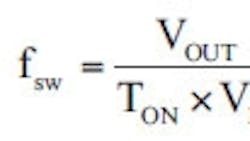Adaptive On-Time DC-DC Converters Combine Speed and Efficiency
Find a downloadable version of this story in pdf format at the end of the story.
Semtech Corp.’s newest EcoSpeed™ dc-dc converters are the SC173 and SC174 synchronous buck regulators. Their dc-dc converter platform incorporates a patented adaptive on-time (AOT) topology intended primarily for point-of-load (POL) applications. The SC173 and SC174 POL regulators satisfy today’s “green” power requirements by efficiently managing both standby and full current demands. Typical applications include office automation, networking and communications equipment; set-top boxes; portable products; power supply modules; and other embedded products.
Figure 1 is a typical configuration of the SC173 regulators. The SC174 configuration is similar, the only difference is their output, the SC173 can supply 3A and the SC174 can supply 4A. Their programmable switching frequency range of 200KHz to 1MHz enables circuit optimization for minimum board space and optimum efficiency.
The SC173 and SC174 converters exhibit advantages over conventional constant on-time control topologies, as shown in Table 1 that compares their characteristics. The adaptive on-time topology in common with hysteretic topologies, enables fast transient response while eliminating the need for external compensation components. This results in simple, space- and cost-efficient power management solutions. However, compared with constant on-time and hysteretic topologies, the adaptive on-time technique provides for more predictable switching frequencies.
Figure 2 shows the simplified circuit for pseudo-fixed frequency, adaptive on-time control. When VFB is less than the internal 750mV reference, the FB Comparator output goes high, turning on the high-side MOSFET via the flip-flop and gate drive. The resulting output ripple triggers the one-shot multivibrator, which sends a single pulse to the high-side MOSFET by way of the flip-flop (F/F) and gate drive. One FB comparator input accepts a percentage of VOUT determined by the voltage divider consisting of R1 and R2, its other input accepts the reference voltage (VREF).
You can configure the SC174 with various capacitor types, such as electrolytic, tantalum, POS and ceramic. For some applications that use low-ESR ceramic capacitors, a signal injection circuit may be implemented to provide 10 mVp-p, as shown in Fig. 3. The on-time control regulates the valley of the output ripple voltage. This ripple voltage is the sum of the two voltages: one produced by the ESR of the output capacitor, and the other due to capacitive charging and discharging of the output capacitor during the switching cycle. For most applications, the output capacitor dominates total output ripple voltage.
In the one-shot multivibrator used in the SC173 and SC174, a current source determined by VIN and RTON charges an internal 2.5pF capacitor. The high-side MOSFET turns off when the capacitor voltage hits VOUT, which is derived internally by the heavily filtered LX voltage. Therefore, at the selected frequency, the IC automatically anticipates the on-time needed to regulate VOUT based on the existing VIN. This method automatically produces an on-time proportional to VOUT and inversely proportional to VIN. Under steady-state operation, you can program the switching frequency from 200kHz to 1MHz, according to:
The SC173 and SC174 use external resistor RTON to set the on-time, which indirectly sets the frequency. You can determine RTON from the desired switching frequency:
The switcher output voltage (VOUT) is regulated by comparing the internal 750mV reference voltage with the percentage of VOUT determined by the R1 and R2 voltage divider at FB. Adjusting the values of the voltage divider controls VOUT.
Continue to next page
Advantages of adaptive on-time control are:
• Predictable operating frequency compared to other variable frequency methods.
• Reduced component count by eliminating the error amplifier and external compensation components.
• Reduced component count by removing the need to sense and control inductor current.
• Fast transient response, controlled by a fast comparator rather than a typically slow error amplifier used in traditional regulator circuits. Figures 4a and 4b illustrate the transient response of an SC174 during a rising and falling load current.
• Operates with ceramic input and output capacitors.
• Reduced output capacitance due to fast transient response
Low Standby Power
Very low power during standby mode is increasingly important to comply with emerging “green” initiatives. However, most electronic products also require fast “wake-up” capability, which demands fast recovery from low-power standby to full-power steady state mode. The SC173 and SC174 converters solve this with an ultrasonic power-save (UPSAVE) mode. UPSAVE reduces the switching frequency to meet low-power standby requirements, which cuts power MOSFET switching losses and results in up to 95% peak standby efficiency. Then, when the load changes from standby to steady state, the EcoSpeed technology cycle-by-cycle response quickly exits UPSAVE mode. To keep the switching frequency from exceeding 25 kHz (high end of the audible range) on-times are prevented from occurring at intervals greater than 40μs.
You can see the effect of power-save in Figures 5 and 6 that show the SC173 and SC174 efficiency vs. output current, respectively. The red curve is with power-save and the blue curve is without power-save.
Circuit Protection
Active loads may leak current from a higher voltage into the switcher output. Under light load conditions with power-save enabled, this can force VOUT to slowly rise and reach the over-voltage threshold, resulting in a hard shutdown. Smart Power Save prevents this condition. When the FB voltage exceeds 10% above nominal (825mV), the ICs immediately disable power-save, and turn on the low-side MOSFET. This draws current from VOUT through the inductor and causes VOUT to fall. When VFB drops back to the 750mV trip point, a normal TON switching cycle begins. This method prevents a hard over-voltage protection (OVP) shutdown and also cycles energy from VOUT back to VIN.
These ICs feature fixed current limiting that employs the RDS(ON) of the lower MOSFET for current sensing. While the low-side MOSFET is on, the inductor current flows through it and creates a voltage across its RDS(ON). During this time, the voltage across the MOSFET is negative with respect to ground. If this MOSFET voltage drop exceeds the internal reference voltage, it activates the current limit. The current limit then keeps the low-side MOSFET on and will not allow another high side on-time, until the current in the low-side MOSFET reduces enough to drop below the internal reference voltage once more.
Additional Protection Features
The SC173 and SC174 synchronous buck regulators incorporate a full range of protection features, including:
• Over-Voltage Protection (OVP)
• Over-Temperature Protection (OTP)
• Output short circuit protection
• Under-voltage lock-out (UVLO)
• Soft-Start
To indicate that the SC173 and SC174 are operating properly, the regulators provide a power good (PGOOD) output, with open-drain that requires a pull-up resistor. When the output voltage is 10% below the nominal voltage, PGOOD goes low and stays low until the output voltage returns to the nominal voltage. PGOOD is held low during soft start and activated approximately 1ms after VOUT reaches regulation. The total PGOOD delay is typically 2ms.
PGOOD will transition low if VFB exceeds +20% of nominal, which is also the over-voltage shutdown threshold (900mV). PGOOD also pulls low if the EN/PSV pin is low when VDD is present.
Summary
Designers wishing to implement point-of-load power circuits now have an energy-saving alternative in the SC173 and SC174 synchronous buck regulators. The parts efficiently manage current in standby and full current modes, using an advanced adaptive on-time topology to provide fast transient response, reduced output capacitance, and predictable switching frequencies.
Download the story in pdf format here.
About the Author

Sam Davis
Sam Davis was the editor-in-chief of Power Electronics Technology magazine and website that is now part of Electronic Design. He has 18 years experience in electronic engineering design and management, six years in public relations and 25 years as a trade press editor. He holds a BSEE from Case-Western Reserve University, and did graduate work at the same school and UCLA. Sam was the editor for PCIM, the predecessor to Power Electronics Technology, from 1984 to 2004. His engineering experience includes circuit and system design for Litton Systems, Bunker-Ramo, Rocketdyne, and Clevite Corporation.. Design tasks included analog circuits, display systems, power supplies, underwater ordnance systems, and test systems. He also served as a program manager for a Litton Systems Navy program.
Sam is the author of Computer Data Displays, a book published by Prentice-Hall in the U.S. and Japan in 1969. He is also a recipient of the Jesse Neal Award for trade press editorial excellence, and has one patent for naval ship construction that simplifies electronic system integration.
You can also check out his Power Electronics blog.
